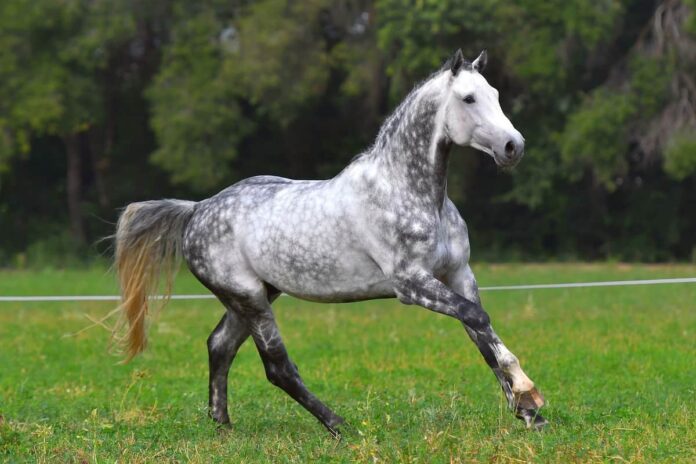Last Updated on November 6, 2023 by Fumipets
Exploring the Elegance of 12 Grey Horse Breeds
Grey horse breeds are known for their captivating coat color, which transitions from a dark shade to a lighter grey over time. These horses are renowned for their versatility, excelling in various equestrian disciplines, from dressage to show jumping.
This guide delves into the world of grey horse breeds, exploring their unique characteristics, historical significance, and suitability for different riding and sporting activities. Whether you’re a seasoned equestrian or simply fascinated by horses, this summary offers valuable insights into these enchanting equines.
Grey Horse Breeds
Grey horses have a grey modifier, which means that when the horse loses its coat, more and more grey hairs become visible. Grey horses are born with some color and may be virtually any hue at birth, but they also have a grey modifier. As a result, a grey horse will age and get increasingly lighter until it is almost completely white.
Although practically any breed of horse may have this colour, several are particularly well-known for it. Details on 12 different breeds of grey horses are provided here.
The 12 Grey Horse Breeds:
1. Andalusian

The ancient Andalusian breed has a significant impact on most contemporary breeds. The Carthusian monastery of Jerez de la Frontera is where the origins of modern-day Andalusian horses may be found. It was said that this monastery secretly retained a small herd of horses throughout the war, and these horses were utilized to replace the stock that was left.
The Andalusian has been sold to nations including the USA and Australia since the second part of the 20th century. The horse is an average of slightly over 15 hands high and seems athletic and powerful. It is used for everyday riding, recreational riding, exhibitions, and competition.
2. Araboulonnais
The Araboulonnais is a new breed, but the Andalusian is said to be one of the oldest. The Boulonnais and Arabians were crossed to produce the French horse.
Although the breed is young and does not yet have fully defined breed standard features, it is known to have an average height of 15.5 hands and is often thought of as a calm and compassionate horse. The breed is often ridden for pleasure and hiking in addition to being utilized for agricultural labor.
3. Boulonnais

The Boulonnais is one of the breeds utilized to produce the new Araboulonnais breed. Despite being a huge draft breed, this horse is regarded as one of the most beautiful. It has a lengthy mane and tail, as well as a white coat. The Boulonnais not only gave rise to the Araboulannais but also had an impact on several other draft breeds.
The Boulonnais is a strong-looking horse that typically stands 16 hands tall. It is a pleasant animal that serves a variety of functions, including riding and serving as a carthorse. As well, it is grown for meat.
4. Camargue Horse
Another breed with French roots is the Camargue. This breed was permitted to run wild and there were no formal breeding operations up to the second part of the 20th century. The horses took after those that had been left behind by passing tourists.
The current Camargue stands up to 14 hands high, and a breeding program and studbook were established in 1978 to preserve the ancient lineage. The Camargue is a sturdy animal that can resist challenging circumstances since it lives on the plains.
5. Carthusian Horse

The Andalusian horse breed has a subset known as the Carthusian. In fact, a lot of people think it’s the breed’s purest variation still in existence. The convent where the horses were stashed during the 18th century fighting gives the animal its name.
The breed may grow up to 16 hands in height and is now exceedingly uncommon. Both as a riding horse and a show horse, it is employed.
6. Chumbivilcas
The Peruvian breed of Chumbivilcas was formerly a favorite of the country’s army due to its toughness and strength. Although they are a little breed, being 14 hands tall, they are powerful. The breed is also regarded as being kind and sociable.
The Chumbivilcas are now more often utilized for transportation and as riding horses than as warhorses. They have a great deal of endurance when riding and can survive on little vegetation.
7. Dilbaz

The Azerbaijani Dilbaz was developed in the 18th century by crossing Turkish and Arabian strains. Breed cooperatives were established in the middle of the 20th century to protect the bloodline and guarantee the breed’s survival and profitability.
The Dilbaz may measure up to 14.5 hands today and can be unpredictable. The Dilbaz is ridden and used to enhance other breeds. It is also used as a pack animal.
8. Kladruby
The Lipizzan breed and the Kladruby both originated in the Czech Republic in the 16th and 17th centuries. They were previously used as carriage horses in Vienna, but a fire in 1759 destroyed 200 years’ worth of breeding records. Since then, breeding has been confined to emphasize individuals with a white back.
Although the Kladruby may reach heights of up to 17 hands, the breed is thought to be in danger because to its tiny population. It is exclusively used for sport driving outside of private ownership.
9. Lipizzan

The Lipizzan horse breed is well-known. They are the breed connected to Vienna’s Spanish Riding School. The Lipizzan is recognized as an Austrian breed even though the breed was named after a hamlet that is currently in Italy, but belonged to Austria at the time the breed was created.
The Lipizzan horse breed, which was developed from the old Iberian type, stands between 15 and 16 hands tall and is exceptionally athletic. Despite having admirers all around the globe who want to see it grow, the breed is still regarded as being uncommon. The vivacious horse is regarded as friendly and is capable of training in a wide range of physical disciplines.
10. Lusitano
Due to their shared heritage, the Lusitano is regarded as the Andalusian’s sibling breed. But the Lusitano was developed specifically for use in bullrings. Its high level of spiritedness and agility make it effective in the bullring but may preclude its usage as a general or recreational rider.
The 15-hand horse is described as having an athletic frame. It is really bold, loving, and clever.
11. Spanish Norman

The Andalusian and Percheron horse breeds from France and Spain, respectively, are combined to create the Spanish Norman. The Spanish Norman was developed to mimic the warhorses of ancient Europe, but the breed’s registration wasn’t created until 1991.
The Spanish Norman, which may reach a height of 17 hands, is a muscular and robust horse that is eager to be taught and ridden. It is also said to be quiet. It is used for training, regular riding, shows, and competitions.
12. Unmol
Punjab is the origin of the Unmol horse breed in India. Its name translates to “priceless,” and Alexander the Great is said to have brought the horse to India for the first time. Although some breeders claim to have instances of the original purebred Unmol, the present breed has developed somewhat more white than the historical breed, which was more grey.
The 15-hand horse is most often employed as a riding horse for both transportation and recreational riding.
Conclusion
Although grey horses may be of any breed, the 12 breeds mentioned above are considered to be “grey breeds” or to have grey coats the most often.
A grey horse’s age may be calculated because as the horse matures, the greying effect becomes lighter and lighter and the coat becomes more and more white.
FAQs About Grey Horse Breeds
What causes the grey coat color in horses?
The grey coat color in horses is primarily caused by a genetic trait that leads to the gradual loss of pigmentation over time, resulting in a coat that lightens with age.
Which grey horse breeds are famous for their contributions to horse sports?
Several grey horse breeds, including the Andalusian and Lipizzaner, have made significant contributions to various equestrian disciplines, particularly in dressage and haute école performances.
Are grey horses more prone to certain health issues?
Grey horses may be more susceptible to skin conditions and sunburn due to their lack of pigmentation in the skin. Proper sun protection and skin care are essential for their well-being.
Can the coat color of grey horses change back to a darker shade?
As grey horses age, their coat color typically lightens, and it rarely darkens. However, genetics and individual variation can influence the extent of the color change.
Are grey horse breeds suitable for beginners in horse riding?
Grey horses, like other breeds, can be suitable for beginners depending on their temperament and training. It’s essential to choose a horse with a temperament that matches the rider’s skill level and goals.


















